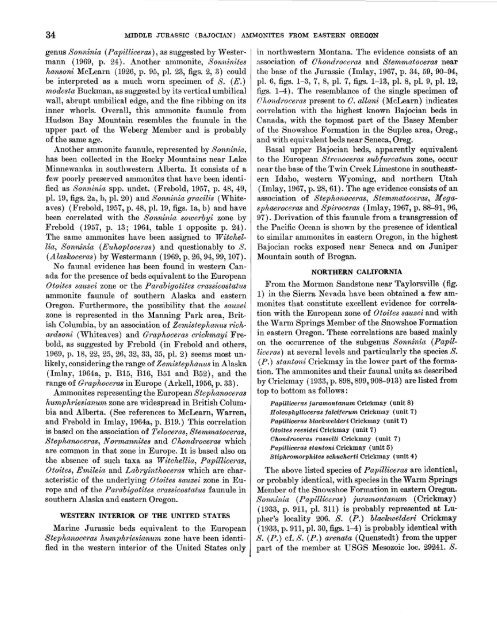Middle Jurassic (Bajocian) Eastern Oregon
Middle Jurassic (Bajocian) Eastern Oregon
Middle Jurassic (Bajocian) Eastern Oregon
Create successful ePaper yourself
Turn your PDF publications into a flip-book with our unique Google optimized e-Paper software.
34 MIDDLE JURASSIC (BAJOCIAN) AMMONITES FROM EASTERN OREGON<br />
genus Sonninia (Papillice1·as), as suggested by Westermann<br />
(1969, p. 24). Another ammonite, Sonninites<br />
hansoni McLearn ( 1926, p. 95, pl. 23, figs. 2, 3) could<br />
be interpreted as a much worn specimen of S. (E.)<br />
modesta Buckman, as suggested by its vertical umbilical<br />
wall, abrupt umbilical edge, and the fine ribbing on its<br />
inner whorls. Overall, this ammonite faunule from<br />
Hudson Bay Mountain resembles the faunule in the<br />
upper part of the Weberg Member and is probably<br />
of the same age.<br />
Another ammonite faunule, represented by Sonninia,<br />
has been collected in the Rocky Mountains near Lake<br />
Minnewanka in southwestern Alberta. It consists of a<br />
few poorly preserved ammonites that have been identified<br />
as Sonninia spp. undet. (Frebold, 1957, p. 48, 49,<br />
pl. 19, figs. 2a, b, pl. 20) and Sonninia gracilis (Whiteaves)<br />
(Frebold, 1957, p. 48, pl. 19, figs. 1a, b) and have<br />
been correlated with the S onninia sowerbyi zone by<br />
Frebold (1957, p. 13; 1964, table 1 opposite p. 24).<br />
The same ammonites have been assigned to Witchellia,<br />
Sonninia (Euhoploceras) and questionably to S.<br />
(Alaskoceras) by Westermann (1969, p. 26, 94, 99, 107).<br />
No faunal evidence has been found in western Canada<br />
for the presence of beds equivalent to the European<br />
Otoites sau.zei zone or the Parabigotites crassicostatus<br />
ammonite faunule of southern Alaska and eastern<br />
<strong>Oregon</strong>. Furthermore, the possibility that the sauzei<br />
zone is represented in the Manning Park area, British<br />
Columbia, by an association of Zemistepltan'us richardsoni<br />
(Whiteaves) and Graphoceras crickmayi Frebold,<br />
as suggested by Frebold (in Frebold and others,<br />
1969, p. 18, 22, 25, 26, 32, 33, 35, pl. 2) seems most unlikely,<br />
considering the range of Zernistephanus in Alaska<br />
(Imlay, 1964a, p. B15, B16, B51 and B52), and the<br />
range of Graphoceras in Europe (Arkell, 1956, p. 33).<br />
A1nmonites representing the European Stephanoceras<br />
hu1nphriesianum zone are widespread in British Columbia<br />
and Alberta. (See references to McLearn, Warren,<br />
and Frebold in Imlay, 1964a, p. B19.) This correlation<br />
is based on the association of Teloceras, Stemmatoceras,<br />
Stephanoceras, N ormannites and Ohond·roceras which<br />
are common in that zone in Europe. It is based also on<br />
the absence of such taxa as Witchellia, Papilliceras,<br />
Otoites, E1nileia and Labryinthoceras which are characteristic<br />
of the underlying Otoites sauze'i zone in Europe<br />
and of the Parabigotites crassicostatus faunule in<br />
southern Alaska and eastern <strong>Oregon</strong>.<br />
WESTERN INTERIOR OF THE UNITED STATES<br />
Marine <strong>Jurassic</strong> beds equivalent to the European<br />
Stephanoceras humphriesianum zone have been identified<br />
in the western interior of the United States only<br />
in northwestern Montana. The evidence consists of an<br />
association of Ohondroceras and Stemmatoceras near<br />
the base of the <strong>Jurassic</strong> (I1nlay, 1967, p. 34, 59, 90-94,<br />
pl. 6, figs. 1-3, 7, 8, pl. 7, figs. 1-13, pl. 8, pl. 9, pl. 12,<br />
figs. 1-4) . The resemblance of the single specimen of<br />
Olwndroceras present to 0. allani (McLearn) indicates<br />
correlation with the highest known <strong>Bajocian</strong> beds in<br />
Canada, with the topmost part of the Basey Member<br />
of the Snowshoe Formation in the Suplee area, Oreg.,<br />
and with equivalent beds near Seneca, Oreg.<br />
Basal upper <strong>Bajocian</strong> beds, apparently equivalent<br />
to the European Stre1wceras sub furcatum zone, occur<br />
near the base of the Twin Creek Limestone in southeastern<br />
Idaho, western Wyoming, and northern Utah<br />
(Imlay, 1967, p. 28, 61). The age evidence consists of an<br />
association of Stephanoceras, Stemmatoceras, Megaspltaeroceras<br />
and Spiroceras (Imlay, 1967, p. 88-91, 96,<br />
97). Derivation of this faunule from a transgression of<br />
the Pacific Ocean is shown by the presence of identical<br />
to similar ammonites in eastern <strong>Oregon</strong>, in the highest<br />
<strong>Bajocian</strong> rocks exposed near Seneca and on Juniper<br />
Mountain south of Brogan.<br />
NORTHERN CALIFORNIA<br />
From the Mormon Sandstone near 'Taylorsville (fig.<br />
1) in the Sierra Nevada have been obtained a few ammonites<br />
that constitute excellent evidence for correlation<br />
with the European zone of Otoites sauzei and with<br />
the Warm Springs Member of the Snowshoe Formation<br />
in eastern <strong>Oregon</strong>. These correlations are based mainly<br />
on the occurrence of the subgenus Sonninia (Papilliceras)<br />
at several levels and particularly the species S.<br />
( P.) stantoni Crickmay in the lower part of the formation.<br />
The a.mmonites and their faunal units as described<br />
by Crickmay ( 1933, p. 898, 899, 908-913) are listed from<br />
top to bottom as follows :<br />
PapilUcera.s juramontanum Crickmay (unit 8)<br />
Holcophylloceras falciterum Crickmay (unit 7)<br />
Papilliceras blackwelderi Crickmay (unit 7)<br />
Otoites reesidei Crickmay (unit 7)<br />
Ohondroceras russelli Grickmay (unit 7)<br />
Papilliceras stantoni Crickmay (unit 5)<br />
Stiphromorphites schucherti Crickmay (unit 4)<br />
The above listed species of Papilliceras are identical,<br />
or probably identical, with species in the Warm Springs<br />
Member of the Snowshoe Formation in eastern <strong>Oregon</strong>.<br />
Smvninia ( Papllliceras) juramontanum ( Crickmay)<br />
(1933, p. 911, pl. 311) is probably represented at Lupher's<br />
locality 206. S. (P.) blackwelderi Crickmay<br />
(1933, p. 911, pl. 30, figs. 1-4) is probably identical with<br />
S. (P.) cf. S. (P.) arenata (Quenstedt) from the upper<br />
part of the member at USGS Mesozoic loc. 29241. S.

















